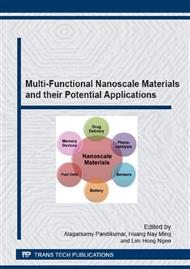[1]
Y. Shiraishi, Y. Sugano, S. Tanaka, T. Hirai, One-pot synthesis of benzimidazoles by simultaneous photocatalytic and catalytic reactions on Pt@TiO2 nanoparticles, Angew. Chem. Int. Ed. 49 (2010) 1656-1660.
DOI: 10.1002/anie.200906573
Google Scholar
[2]
Q. Wang, M. Zhang, C. Chen, W. Ma, J. Zhao, Photocatalytic aerobic oxidation of alcohols on TiO2: the acceleration effect of a Bronsted acid, Angew. Chem. Int. Ed. 49 (2010) 7976-7979.
DOI: 10.1002/anie.201001533
Google Scholar
[3]
A. Zanella, Control of apple superficial scald and ripening - a comparison between 1-methylcyclopropene and diphenylamine postharvest treatments, initial low oxygen stress and ultra low oxygen storage, Postharvest Biol. Technol. 27 (2003) 69-78.
DOI: 10.1016/s0925-5214(02)00187-4
Google Scholar
[4]
Y.C. Chang, P.W. Chang, C.M. Wang, Energetic probing for the electron transfer reactions sensitized by 9, 10-dicyanoanthracene and 9-cyanoanthracene and their modified zeolite particles, J. Phys. Chem. B 107 (2003) 1628-1633.
DOI: 10.1021/jp021852j
Google Scholar
[5]
T.S. Lin, J. Retsky, ESR studies of photochemical reactions of diphenylamines, phenothiazines, and phenoxazines, J. Phys. Chem. 90 (1986) 2687-2689.
DOI: 10.1021/j100403a026
Google Scholar
[6]
C. Karunakaran, S. Karuthapandian, Solar photooxidation of diphenylamine, Sol. Energy Mater. Sol. Cells 90 (2006) 1928-(1935).
DOI: 10.1016/j.solmat.2005.12.003
Google Scholar
[7]
K.L. Hardee, A.J. Bard, Semiconductor electrodes: X _Photoelectrochemical behavior of several polycrystalline metal oxide electrodes in aqueous solutions, J. Electrochem. Soc. 124 (1977) 215-224.
DOI: 10.1149/1.2133269
Google Scholar
[8]
D.M. Adams, J.B. Raynor, Advanced Practical Inorganic Chemistry, John Wiley, New York, (1965).
Google Scholar
[9]
S. Puri, W.R. Bansal, K.S. Sidhu, Benzophenone-sensitized photooxidation of diphenylamine, Indian J. Chem. 11 (1973) 828.
Google Scholar
[10]
W.R. Bansal, N. Ram, K.S. Sidhu, Reaction of singlet oxygen: part I – oxidation of diphenylamine with singlet oxygen (1Δg) produced in situ, Indian J. Chem. 14B (1976) 123-126.
DOI: 10.1002/chin.197628132
Google Scholar
[11]
M.A. Fox, C.C. Chen, Mechanistic features of the semiconductor photocatalyzed olefin-to-carbonyl oxidative cleavage, J. Am. Chem. Soc. 103 (1981) 6757-6759.
DOI: 10.1021/ja00412a044
Google Scholar
[12]
B. Ohtani, Photocatalysis A to Z - What we know and what we do not know in a scientific sense, J. Photochem. Photobiol. C 11 (2011) 157-178.
DOI: 10.1016/j.jphotochemrev.2011.02.001
Google Scholar
[13]
C. Karunakaran, S. Senthilvalen, S. Karuthapandian, TiO2-photocatalyzed oxidation of aniline, J. Photochem. Photobiol. A 172 (2005) 207-213.
DOI: 10.1016/j.jphotochem.2004.12.010
Google Scholar
[14]
L. Vincze, T.J. Kemp, Light flux and light flux density dependence of the photomineralization rate of 2, 4-dichlorophenol and chloroacetic acid in the presence of TiO2, J. Photochem. Photobiol. A 87 (1995) 257-260.
DOI: 10.1016/1010-6030(94)03985-4
Google Scholar
[15]
C. Karunakaran, S. SakthiRaadha, P. Gomathisankar, P. Vinayagamoorthy, Nanostructures and optical, electrical, magnetic, and photocatalytic properties of hydrothermally and sonochemically prepared CuFe2O4/SnO2, RSC Adv. 3 (2013) 16728-16738.
DOI: 10.1039/c3ra41872c
Google Scholar
[16]
M. Li, M.E. Noriega-Trevino, N. Nino-Martinez, C. Marambio-Jones, J. Wang, R. Damoiseause, F. Ruiz, E.M.V. Hock, Synergistic bactericidal activity of Ag-TiO2 nanoparticles in both light and dark conditions, Environ. Sci. Technol. 45 (2011).
DOI: 10.1021/es201675m
Google Scholar
[17]
Y. Xu, M.A.A. Schoonen, The absolute energy positions of conduction and valence bands of selected semiconducting materials, Am. Mineral. 85 (2000) 543-556.
DOI: 10.2138/am-2000-0416
Google Scholar
[18]
R. Katoh, A. Furube, T. Yoshihara, K. Hara, G. Fujihashi, S. Takano, S. Murata, H. Arakawa, M. Tachiya, Efficiencies of electron injection from excited N3 dye into nanocrystalline semiconductor (ZrO2, TiO2, ZnO, Nb2O5, SnO2, In2O3) films, J. Phys. Chem. B 108 (2004).
DOI: 10.1021/jp031260g
Google Scholar


